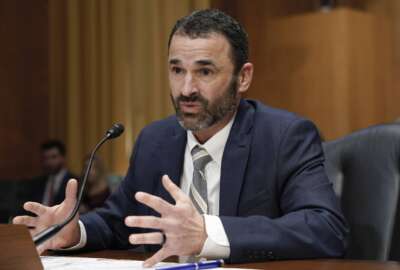Hubbard Radio Washington DC, LLC. All rights reserved. This website is not intended for users located within the European Economic Area.
On Air: Federal News Network
Trending:
Analysis: What the decline in bid protests really means
Experts say the 2 percent drop in the number of contracting complaints to GAO disproves the theory that as federal spending drops, contractors will file more pr...
wfedstaff | April 17, 2015 6:03 pm
Federal contractors brought fewer complaints to the Government Accountability Office in fiscal 2013. This was the first time since 2006 that the number of bid protests didn’t increase year-over-year.
At the same time, agencies continue to cut the amount of money they spend on goods and services.
Preliminary estimates by GAO show agencies spent about $460 billion last year—more than a 10 percent decline as compared to 2012. The Office of Federal Procurement Policy said in 2012 agencies spent about $513 billion on acquisition.
These latest bid protests and spending figures provide little evidence of what many believed would be the case: as agencies cut procurement spending, more vendors will protest to GAO or the Court of Federal Claims.
Instead, Ralph White, the managing associate general counsel for procurement law at GAO, said the latest figures show the opposite is happening.
“At some point, as the amount of spending on federal contracts drops, it does make sense that the total number protest filings might drop,” White said in an interview with Federal News Radio.
2 percent decline in 2013
GAO released its latest report to Congress Jan. 2 on the number of bid protests for 2013.
GAO said it received 2,298 bid protests in 2013, of which 509 went all the way through the process to a decision. GAO sustained 87 total cases, or 17 percent of all bid protests.
Dan Gordon, a former administrator in the Office of Federal Procurement Policy and a GAO procurement attorney, and now the associate dean for Government Procurement Law at The George Washington University Law School in Washington, said the amount of money agencies spent on procurement decreased each of the last four years, yet the number of bid protests continued to creep up between 2009 and 2012.
Gordon said the real measure is the effectiveness rate and what happens to the other 900-plus protests that don’t go through the entire process.
Gordon said he’s researching at GWU on what happens to the contractors when the agency agrees to take corrective action instead of going through the bid protest process.
“We are still working the data. There’s a significant percentage where it looks like the protester did get the contract and in that sense it was very much an effective process,” he said. “It’s not clear to me yet whether that’s 20 percent or maybe as much as 23 or 24 percent of those 940 cases last year that were dismissed because the agency took voluntary corrective action,” Gordon said. “In a great majority of the cases, it looks like the agency took corrective action, GAO dismissed and then the protestor did not get the contract.”
Gordon said the protestor may have received other benefits, such as a subcontract or information about its bid that will help them in the future. He said his research, however, focuses just on whether or not the vendor received the contract. Gordon expects the research to be finalized later this winter.
Stay or go
White said the effectiveness rate shows agencies and vendors have a solid understanding of the likelihood of success in a bid protest. GAO said it was effective in 43 percent of all cases, increasing by one percent for the first time since 2009.
“I think it is significant because it is a percentage of all cases filed,” he said. “It does tell us that in a fairly high number of cases, the government is looking at the complaints that have been raised and making a decision about whether to continue to defend against that protest or to proactively take steps to address the situation.”
Another commonly held belief in the federal community relating to bid protests has been vendors bringing more complaints over task order awards under multiple award contracts before GAO. Congress approved the ability of vendors to protest task order awards worth more than $10 million to GAO in 2008.
White said GAO saw 259 protests that were based on task order awards—about 1 in 10 protests.
“In 1994, the Federal Acquisition Streamlining Act was the beginning of the time in which no forum had jurisdiction to hear challenges to the award of task orders under these large multiple award contracts,” he said. “The dip [in the number of protests] was really the effect of having no forum being able to look at those kinds of procurements and so the number of protests fell. Starting in 2008, we got jurisdiction to hear those kinds of protests provided the task order is over $10 million. It makes perfect sense to me that the numbers would be back to where they were in 1995.”
Gordon said those who thought the sky would fall because Congress allowed vendors to protest task orders have been proven wrong. In fact, he said the $10 million threshold is too high.
“I’m concerned that an agency could be spending $9 million on a task order without the accountability and transparency a bid protest can provide,” he said. “I would probably lower the protest bar to $5 million because that’s the level which Congress said you do have to have more formal competition. I would allow protests if you had a more formal competition.”
For the first time, GAO analyzed the most common reasons why it sustained a protest.
White said in the past the agency had surmised the causes, but never looked at it analytically.
GAO found the top reasons were:
- Failure to follow the solicitation evaluation criteria.
“That one is interesting to me because it seems agencies should be able to see that. It might be even higher if you thought about all the cases where agency lawyers advised their agency to take corrective action rather than defend those,” White said.
- Inadequate documentation by the agency to how it reached its conclusions.
“When I first thought about it, I was thinking about it in three separate ways. Sometimes there is inadequately documented source selection decisions; sometimes there’s inadequate documentation of past performance assessment; or inadequate documentation of a technical conclusion. No matter where it’s coming up, it’s the same problem: not really documenting and explaining the basis for the conclusion,” he said.
- Unequal treatment of offerors.
- Unreasonable price or cost evaluation.
“I think bid protests have remained remarkably steady over the years in terms of when there is more spending, there are more protests, and when spending goes down, protests seem to go down. There are some changes at the edges. I think there will be an overall drop as the spending drops. We will see if this is a single year’s event or if it’s the beginning of something more meaningful. We will just have to see.”
RELATED STORIES:
OMB increasing temp of strategic sourcing
Bid protests holding steady, near record highs
Bid protests increase in 2012, nearing 15-year high
Copyright © 2024 Federal News Network. All rights reserved. This website is not intended for users located within the European Economic Area.
Jason Miller
Jason Miller is executive editor of Federal News Network and directs news coverage on the people, policy and programs of the federal government.
Follow @jmillerWFED





